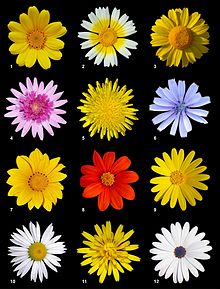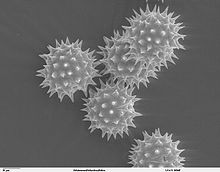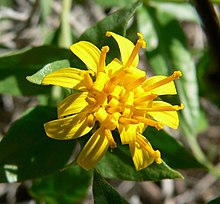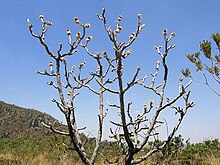Daisy family
| Daisy family | ||||||||||||
|---|---|---|---|---|---|---|---|---|---|---|---|---|

Marguerite ( Leucanthemum vulgare ), Asteroideae , |
||||||||||||
| Systematics | ||||||||||||
|
||||||||||||
| Scientific name | ||||||||||||
| Asteraceae | ||||||||||||
| Bercht. & J. Presl |
The daisy family (botanically Asteraceae or Compositae ), also called daisy family , aster family or cap flower family, are the largest family of the order of the aster-like (Asterales) within the flowering plants (Magnoliopsida). About 10% of the species of flowering plants belong to the Asteraceae. The German name composites and the botanical name Compositae ( Latin for 'compound') are derived from the shape of the inflorescence .
The Asteraceae family contains around 1,600 to 1,700 genera with around 24,000 species and is represented worldwide on all continents, except for Antarctica , in all climatic zones . In Europe it is one of the most species-rich plant families.

1. Anthemis tinctoria (Asteroideae),
2. Glebionis coronaria ( Asteroideae ),
3. Coleostephus myconis (Asteroideae),
4. Chrysanthemum spec. (Herbaceous),
5. Sonchus oleraceus ( Cichorioideae )
6. Cichorium intybus (Cichorioideae)
7. Gazania rigens (Cichorioideae)
8. Tithonia rotundifolia (herbaceous),
9. Calendula arvensis (herbaceous),
10 Leucanthemum vulgare (Asteroideae ), 11. Hieracium lachenalii (Cichorioideae), 12. Osteospermum ecklonis (Asteroideae)
description
Appearance and leaves
There are mostly one to two years or perennial herbaceous plant species, but there are also woody species: subshrubs and shrubs , rarely vines or trees . There are monocarpic and polycarpic species. There are species in almost every type of habitat , only a few species grow as real epiphytes or aquatic plants. In some taxa , the plants contain milky sap .
The arrangement of the leaves is mostly alternate, rarely opposite or whorled; they are often combined into a basal rosette. The stalked to sessile leaves rarely have simple, often pinnate to pinnate leaf blades. They are herbaceous to leathery, sometimes they are transformed into thorns . The leaf margin is smooth, wavy, lobed, serrate, serrated or toothed. There are usually no stipules present.
Inflorescences
In different, differently structured total inflorescences, the flower heads stand on more or less leafless inflorescence shafts or they stand individually.
The cup-shaped inflorescences are typical of this family . The bracts surround the flower heads and form the involucre ("calyx"). The conically elongated or flattened inflorescence axis , the flower base, the flower bed (Clinanthium, Phoranthium), of the individual flowers, which together form the flower head (Calathium, Anthodium), is glabrous and smooth or hairy. The bottom of the cup can have seated, scale-shaped bracts , the so-called chaff leaves (Palea).
A flower head contains one to a thousand flowers, depending on the species. The flowers of a flower head develop and bloom from the outside to the inside (centripetal).
blossoms
The hermaphroditic or unisexual flowers are usually five-fold. The sepals are partially or completely reduced, in many taxa they are transformed into a characteristic fringe of hair or, less often, a membranous border; this flying machine for the fruit is called pappus . The petals are fused to form a tube. There is only one circle with three to five fertile stamens . The stamens are short. The anthers (anthers) are fused into a tube and form a typical feature of the family. Two carpels have become an under constant ovary grown. The stylus , with always two stylus branches, push through the anthers tube and push the pollen out of the tube with purging hairs that are located on the outside or at the tip of the stylus. Only then will the scar become fertile.

There are two basic flower shapes in the family: radially symmetrical tubular flowers (disc flowers) and zygomorphic ray flowers (ray flowers). Depending on the subfamily, both flower forms are present together or just one of them.
The flower formula is or .
fruit
The fruit is usually a special form of a nut, the achene , usually with a pappus that can be in the form of scales, bristles or hair.

ecology
The flower heads look like individual flowers and also function as a whole to attract pollinators from an ecological point of view . These are flowers in which many, small individual flowers are grouped together, so they form a pseudanthium . At the edge of the basket flowers arranged florets often reinforce the impression that it is in the inflorescence is a single bloom.
Synecology
The pollination is mainly by insects or by the wind.
The unit of spread ( diaspore ) is the achene . The achenes are spread either by the wind through the flying hair or by animals. The involucral leaves form z. B. with the great burdock ( Arctium lappa ) hooks at the tip, which get caught in the fur of mammals or in the clothing of humans, only to fall off again later at another point. This is a special form of zoochory called epizoochory .
ingredients
Many species are rich in essential oils that are found in very characteristic glandular scales. Inulin is often formed as a reserve substance .
use
Individual species of the Asteraceae family and especially their cultivated forms are used in a variety of ways. Here is an incomplete list with the plant part that is mainly used:

- As a salad or vegetable:
- Chicory ( Cichorium intybus var. Foliosum ): Leaf
- Endive salad ( Cichorium endivia ): leaf
- Cardy or vegetable artichoke ( Cynara cardunculus) : inflorescence
- Artichoke ( Cynara scolymus ): inflorescence
- Jerusalem artichoke or earth pear ( Helianthus tuberosus ): tuber
- Lettuce ( Lactuca sativa convar. Sativa ): leaf
- Black salsify ( Scorzonera hispanica ): root
- Yacon ( Smallanthus sonchifolia ): root
- Mexican tarragon ( Tagetes lucida )
- Dandelion ( Taraxacum officinale ): root, leaf
- Oat root ( Tragopon porrifolium ): root
- As a medicinal and aromatic plant:
- Arnica ( Arnica montana ): leaf
- Wormwood ( Artemisia absinthium ): leaf
- Rowan ( Artemisia abrotanum ): leaf
- Tarragon ( Artemisia dracunculus ): leaf
- Mugwort ( Artemisia vulgaris ): flower
- Marigold ( Calendula officinalis ): flower
- Bitter thistle ( Centaurea benedicta ): leaf
- Purple coneflower ( Echinacea purpurea )
- Common elephant ( Inula helenium ): root
- Real chamomile ( Matricaria chamomilla , Syn .: Matricaria recutita ): flower
- For the extraction of vegetable oils:
- Ramtill herb ( Guizotia abyssinica )
- Safflower, safflower ( Carthamus tinctorius ): Flower seeds
- Sunflower ( Helianthus annuus ), seeds
- Other:
- Stevia rebaudiana leaves, used to extract sweeteners as a sugar substitute
- Root or coffee chicory ( Cichorium intybus ): root
- Dyer-lip ( Serratula tinctoria ): Leaf
- Dalmatian insect flower ( Tanacetum cinerariifolium , Syn .: Pyrethrum cinerariifolium , Chrysanthemum cinerariifolium ): blossom
- Rotblütige Wucherblume , Armenian insects Flower , Caucasian insect flower , Persian insect flower ( Tanacetum coccineum , Syn .: Chrysanthemum coccineum , Pyrethrum roseum ): Flower
- Ornamental plants:
A great abundance of species and their varieties are used as ornamental plants in all parts of the world. They are planted in parks and gardens or serve as cut and dried flowers.
Development history
Asteraceae fossil finds are mostly pollen deposits and fruits. There are only a few pollen records from the Eocene , but from the Oligocene and Miocene , the pollen of the Asteraceae is common. The importance of the family in the earth's ecosystems has increased from the Middle Oligocene to the present day.
Recently, pollen fossil finds and molecular genetic studies (of ndhF and rbcL genes) have been used to uncover the origin of the Asteraceae. Bremer and Gustafsson 1997 or Kim et al. 2005 concluded that the origin is at least 38 million years ago, probably in the Middle Eocene (42 to 47 million years ago).
The current distribution of the closest related families Goodeniaceae and Calyceraceae and the basal and isolated subfamily Barnadesioideae suggest that the origin of the family was on Gondwana in what is now South America , Antarctica and Australia .








Systematics
The Asteraceae family contains around 1600 to 1700 genera with around 24,000 species . According to phylogenetic knowledge, twelve subfamilies were introduced, which contain a total of about 43 tribes .
- Subfamily Asteroideae
Lindl. : It is the largest subfamily with about 65% of the species. It contains about 20 tribes, 1135 genera with about 16,200 species, with worldwide distribution. In addition to tubular flowers, ray florets are often found on the edge of the inflorescence. The ray-florets have three corolla lobes:
- Tribus Anthemideae Cass.
- Tribe Astereae Cass.
- Tribe Athroismeae Panero
- Tribus Bahieae B.G.Baldwin
- Tribe Calenduleae Cass.
- Tribus Chaenactideae B.G.Baldwin
- Tribe Coreopsideae Lindl.
- Tribe Eupatorieae Cass.
- Tribus Feddeeae Pruski, P. Herrera, Anderb. & Franc. location.
- Tribe Gnaphalieae (Cass.) Lecoq. & Juillet
- Tribe Helenieae Lindl.
- Tribe Heliantheae Cass.
- Tribe Inuleae Cass.
- Tribe Madieae Jeps.
- Tribus Millerieae Lindl.
- Tribe Neurolaeneae Rydb.
- Tribus Perityleae B.G.Baldwin
- Tribe Polymnieae (H.Rob.) Panero
- Tribe Senecioneae Cass.
- Tribus Tageteae Cass.
- Subfamily Barnadesioideae (D.Don) Bremer & Jansen : It is the basal group of the family and the sister group to all other Asteraceae and contains around 88 species about 1% of the species of the Asteraceae. It contains only one tribe:
- Tribus Barnadesieae D.Don : It contains nine genera with about 94 mostly woody species. With a distribution only in South America, especially in the Andes. The corolla tube is two-lipped (lip or tongue) (one lip / tongue is formed from four petals, the other from one petal):
- Arnaldoa Cabrera : The three or so species occur in South America.
- Barnadesia Mutis ex L. f. : It contains about 19 species in South America, particularly in the tropical Andes.
- Chuquiraga Juss. (Syn .: Johannia Willd. ): It contains about 22 species in the Andes and Patagonia.
- Dasyphyllum Kunth (Syn .: Flotovia Spreng. ): It contains about 41 species in Chile.
- Doniophyton Wedd. : There are about two species in South America.
-
Duseniella K. Schum. : It contains only one type:
- Duseniella patagonica (O.Hoffm.) K.Schum. : It occurs in the arid, Argentine part of Patagonia .
-
Fulcaldea Poir. : It contains only one type:
- Fulcaldea laurifolia (Bonpl.) Poir. : It occurs in Ecuador and Peru.
-
Huarpea Cabrera : it contains only one species:
- Huarpea andina Cabrera : It occurs only in Argentina.
-
Bad endalia Less. (Syn .: Chamissomneia Kuntze ): It contains only one species:
- Bad endalia luzulifolia Less. : It occurs only in the pampas in the Brazilian state of Rio Grande do Sul .
- Tribus Barnadesieae D.Don : It contains nine genera with about 94 mostly woody species. With a distribution only in South America, especially in the Andes. The corolla tube is two-lipped (lip or tongue) (one lip / tongue is formed from four petals, the other from one petal):
- Subfamily Carduoideae Sweet : It contains four tribe, 83 genera with over 2,700 species, with worldwide distribution, most species in the northern hemisphere . There are only tubular flowers:
- Tribe Cardueae Cass.
- Tribe Dicomeae Panero & VAFunk
- Tribus Oldenburgieae S. Ortiz
- Tribe Tarchonantheae Kostel.
- Subfamily Cichorioideae Chev. : It contains about 15% of the species, in about seven tribe, 224 genera and 3600 species, with a worldwide distribution. The inflorescences contain only ray flowers in the representatives occurring in Central Europe. The tongue is made up of five corolla lobes:
- Tribe Arctotideae Cass.
- Tribe Cichorieae Lam. & DC.
- Tribe Eremothamneae H.Rob. & Brettell
- Tribe Liabeae (Cass. Ex Dum.) Rydb.
- Tribe Moquinieae H.Rob.
- Tribus Platycarpheae V.A. Funk & H.Rob.
- Tribus Vernonieae Cass.
- Subfamily Corymbioideae Panero & Funk : It contains only one tribe:
- Tribe Corymbieae Panero & VAFunk : It contains only one genus:
- Corymbium L .: The seven or so species occur in South Africa .
- Tribe Corymbieae Panero & VAFunk : It contains only one genus:
- Subfamily Gochnatioideae Panero & Funk : It contains only one tribe:
- Tribus Gochnatieae (Benth. & Hook. F.) Panero & VAFunk : It contains four to five genera with around 90 species. The pappus consists of bristles:
- Cnicothamnus Griseb. : It contains only two species in Bolivia and Argentina.
-
Cyclolepis Gillies ex D.Don : It contains only one species:
- Cyclolepis genistoides D.Don : It occurs in South America.
- Gochnatia Kunth (Syn .: Pentaphorus D.Don ): It contains about 72 species in the Neotropic.
-
Leucomeris D.Don : It contains only one species:
- Leucomeris decora In short : It occurs in China, Myanmar, Thailand and Vietnam.
- Richterago Kuntze : It contains about six species in Brazil.
- Tribus Gochnatieae (Benth. & Hook. F.) Panero & VAFunk : It contains four to five genera with around 90 species. The pappus consists of bristles:
- Subfamily Gymnarrhenoideae Panero & VAFunk : It contains only one tribe:
-
Gymnarrheneae Panero & VAFunk : It contains only one genus:
- Gymnarrhena Desf. : Contains only one to six species, with a distribution from North Africa to the Middle East.
-
Gymnarrheneae Panero & VAFunk : It contains only one genus:
- Subfamily Hecastocleioideae Panero & Funk : It contains only one tribe:
- Tribe Hecastocleideae: It contains only one genus ( monogeneric taxon):
-
Hecastocleis A.Gray : It contains only one species:
- Hecastocleis shockleyi A.Gray : It occurs in the southwestern USA. The flower head contains only one flower and the pappus consists of scales.
-
Hecastocleis A.Gray : It contains only one species:
- Tribe Hecastocleideae: It contains only one genus ( monogeneric taxon):
- Subfamily Mutisioideae Lindl. : It contains three to four tribes and 44 genera with 630 species, mainly in South America, but also in Africa, Asia and Australia. The corolla tube is two-lipped (lip or tongue) (one lip / tongue is formed from two, the other from three petals.):
- Tribe Mutisieae Cass.
- Tribe Onoserideae (Bentham) Panero & VAFunk
- Tribus Nassauvieae Cass.
- Subfamily Pertyoideae Panero & Funk : It contains only one tribe:
- Tribe Pertyeae Panero & VAFunk : It contains five to six genera with 70 species from Afghanistan to eastern Asia. The corolla tube is deep, unevenly divided:
- Ainsliaea DC. : It contains almost 70 species from eastern Asia to western Malesia.
-
Catamixis Thomson : It contains only one species:
- Catamixis baccharoides Thomson : It occurs in the northwestern Himalayas.
-
Diaspananthus Miq. : It contains only one type:
- Diaspananthus uniflorus (Sch.Bip.) Kitam. : It only occurs on the Japanese island of Honshū .
- Macroclinidium Maxim. : It contains about seven species mainly in Japan.
- Myripnois Bunge : It contains about three species in India, Sri Lanka and Southeast Asia.
- Pertya Sch.Bip. : The approximately 23 species are distributed in Afghanistan, Thailand, China and Japan. There are 17 species in China, 16 of them only there.
- Tribe Pertyeae Panero & VAFunk : It contains five to six genera with 70 species from Afghanistan to eastern Asia. The corolla tube is deep, unevenly divided:
- Subfamily Stifftioideae Panero : It contains only one tribe:
- Tribus Stifftieae D.Don : It contains ten to eleven genera with around 40 species in the Andes and northeastern South America.
- Subfamily Wunderlichioideae Panero & Funk : It contains two tribes and about eight genera and 24 species in eastern South America and southwestern China:
- Tribe Hyalideae Panero : It contains about three genera:
- Hyalis D. Don ex Hook. & Arn. : It contains only two species in South America.
-
Ianthopappus Rogue & DJNHind : It contains only one species:
- Ianthopappus corymbosus (Less.) Roque & DJNHind : It occurs in Brazil.
-
Nouelia Franch. : It contains only one type:
- Nouelia insignis franch. : It thrives at altitudes between 1000 and 2900 meters in the Chinese provinces of southwest Sichuan and Yunnan.
- Tribus Wunderlichieae Panero & VAFunk : It contains about four genera with almost 40 species in South America:
- Chimantaea Maguire et al. : The nine or so species occur in Venezuela and Guyana .
- Stenopadus S.F.Blake : It contains about 14 species mainly on the Guiana shield.
- Stomatochaeta (SFBlake) Maguire & Wurdack : The roughly six species occur in Venezuela, northern Brazil and Guyana.
- Wunderlichia Riedel ex Benth. & Hook. f. : The approximately nine species occur in Brazil.
- Tribe Hyalideae Panero : It contains about three genera:
Pedigree according to Panero & Funk 2008:
swell
- The Asteraceae family on the AP website . (Sections systematics and description)
- The Asteraceae family at DELTA. (Section description)
- Theodore M. Barkley, Luc Brouillet, John L. Strother: Asteraceae. : Same text online as the printed work , In: Flora of North America Editorial Committee (Ed.): Flora of North America North of Mexico. Volume 19, 20 and 21: Magnoliophyta: Asteridae, part 7: Asteraceae , in three parts. Oxford University Press, New York and Oxford, 2006. (Sections Systematics and Description)
- The Asteraceae family in the Western Australian flora . (Section description)
- The Asteraceae family in the identification exercises at the University of Ulm.
- Thomas Schöpke, 2006: Description of the family and subfamilies at pharmakobotanik.de .
- Jose L. Panero, Vicki A. Funk: The value of sampling anomalous taxa in phylogenetic studies: major clades of the Asteraceae revealed. In: Molecular Phylogenetics and Evolution , Volume 47, 2008, pp. 757-782: PDF . doi : 10.1016 / j.ympev.2008.02.011
- Vicki A. Funk, Alfonso Susanna, Tod F. Stuessy, Randall J. Bayer: Systematics, Evolution and Biogeography of the Compositae , 2009. IAPT (International Association for Plant Taxonomy), ISBN 978-3-9501754-3-1 . (Sections systematics and description)
- Randy Bayer, Alfonso Delgado, Vicki Funk, Marinda Koekemoer & Christoph Oberprieler (Program committee): TICA = The International Compositae Alliance .
- J. Mauricio Bonifacino, Vicki A. Funk: Compositae Classification: Revisited, reevaluated, reeverythinged : Compositae-Metatree-Poster. (PDF file; 2.96 MB)
Individual evidence
- ↑ Useful plants of the Asteraceae, p. 25, in Small useful plant systematics (internship) by Christoph Reisdorff & Reinhard Lieberei, University of Hamburg - Biozentrum Klein Flottbek. ( Memento of the original from February 1, 2012 in the Internet Archive ) Info: The archive link was inserted automatically and has not yet been checked. Please check the original and archive link according to the instructions and then remove this notice. (PDF file; 229 kB)
- ^ Jose L. Panero: Economically Important Sunflowers .
- ↑ Jose L. Panero, Bonnie S. Crozier, 2008: Entry in the Tree of Life project .
- ↑ ML DeVore, TF Stuessy: The place and time of origin of the Asteraceae with additional comments on the Calyceraceae and Goodeniaceae. In: DJN Hind et al. (Ed.): Advances in Compositae Systematics , 1995, pp. 23-40.
- ↑ Asteraceae in the Germplasm Resources Information Network (GRIN), USDA , ARS , National Genetic Resources Program. National Germplasm Resources Laboratory, Beltsville, Maryland.
- ↑ Family tree in the Tree of Life project .


![\ downarrow K _ {{0- \ infty}} \; C _ {{[(5)}} A _ {{(5)]}} \; G _ {{\ overline {(2)}}}](https://wikimedia.org/api/rest_v1/media/math/render/svg/40cac66163a9240b0e3594426bde44738fcbcb26)


